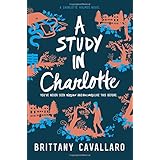 Heather W. Petty's Lock & Mori is the sixth and final book in my Sherlock Holmes related reading tour. It is a contemporary, young adult novel set in London featuring a teenage version of the consulting detective. There is a Watson but he barely makes an appearance. Instead, the crime solving duo at the center of this story is comprised of a female James "Mori" Moriarty and a male Sherlock Holmes whom Mori nicknames "Lock". Although Lock gets top billing in the title, this is Mori's story.
Heather W. Petty's Lock & Mori is the sixth and final book in my Sherlock Holmes related reading tour. It is a contemporary, young adult novel set in London featuring a teenage version of the consulting detective. There is a Watson but he barely makes an appearance. Instead, the crime solving duo at the center of this story is comprised of a female James "Mori" Moriarty and a male Sherlock Holmes whom Mori nicknames "Lock". Although Lock gets top billing in the title, this is Mori's story.Lock initiates their partnership by suggesting that he and Mori play a game. He takes her to a crime scene where the two observe from a distance as the police go about their investigation of a dead body and the area surrounding it. Lock challenges Mori to see which of them can solve the murder first. The only rule is that they must share information. At first Mori rejects his proposal with half-hearted protests about how murder shouldn't be a game. But when she spots of a photo of her own mother with the murder victim, Mori cannot help but investigate. And since Lock and Mori are in high school (or whatever the British equivalent of high school is) and are opposite genders, of course there is a romance added into the mix.
I had mixed feelings about this one. On the positive side, I read on Goodreads where the author mentioned that in Doyle's original stories no one but Sherlock ever meets Moriarty. That got her thinking about what if the two knew each other long ago and something happened that turned them into enemies. With that in mind, Lock & Mori could be seen as a prequel telling the story of how Lock and Mori became friends and then enemies. That is an interesting take on the Sherlock Holmes story that I haven't read before.
In the minus column, the identity of the killer is made clear pretty early on, which is rarely a good thing in a murder mystery. Once that mystery solved, the remaining questions to be answered were why and how the murderer would be stopped. That it would be Mori stopping the murderer was never really a question. That brings me to my next issue, is that this really isn't Lock's story. Which could be okay, but if there isn't a Sherlock solving a crime then it isn't a very Sherlock story. And Mori as a lead character was... frustrating. Despite her intellect she makes bad decision after bad decision. I had to constantly remind myself that Mori was only a teenager and that her bad decisions were exactly the kind of idiotic things a teenager might do (but not a teenage Sherlock because that just isn't how Sherlock works).
Mori and Lock were also too much alike. They were both very smart and observant. They were both moody. Neither seemed to have very many friends. They were both all about solving the puzzle. In real life two people who share similar interests and traits may make for an ideal partnership. On paper they make for a rather bland duo. I like that they were both smart but they needed to be smart in different ways. They needed to balance and complement each other rather than merely mirroring each other.
Despite my issues with the book I do want to know what happens next. We already know their relationship can't last. The only question is what will blow it up and how.
 A Study in Charlotte is a contemporary young adult mystery featuring a teenaged Holmes and Watson. They go by the names Charlotte and James (sometimes Jamie though he doesn't particularly like the nickname). The central conceit of A Study in Charlotte is that Sherlock Holmes, John Watson, and James Moriarty were all real people whose respective descendants, with a few exceptions, don't get along. This is not particularly surprising in the case of the Moriarty family, but even Holmeses and the Watsons keep their distances from one another.
A Study in Charlotte is a contemporary young adult mystery featuring a teenaged Holmes and Watson. They go by the names Charlotte and James (sometimes Jamie though he doesn't particularly like the nickname). The central conceit of A Study in Charlotte is that Sherlock Holmes, John Watson, and James Moriarty were all real people whose respective descendants, with a few exceptions, don't get along. This is not particularly surprising in the case of the Moriarty family, but even Holmeses and the Watsons keep their distances from one another.  My Sherlock Homes themed reading series continues with A Study in Scarlet Women by Sherry Thomas. It is the first in a new series dubbed The Lady Sherlock series. In this first book readers get an origin story as to how Charlotte Holmes, youngest of Lord and Lady Holmes's four daughters, becomes the famous and much sought after detective, Sherlock.
My Sherlock Homes themed reading series continues with A Study in Scarlet Women by Sherry Thomas. It is the first in a new series dubbed The Lady Sherlock series. In this first book readers get an origin story as to how Charlotte Holmes, youngest of Lord and Lady Holmes's four daughters, becomes the famous and much sought after detective, Sherlock.